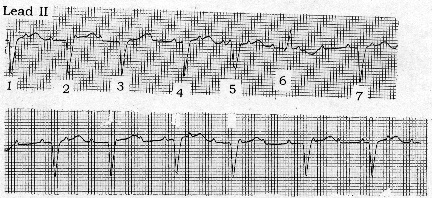


Parasympathetic predominates => slower HR => longer PR interval.Sympathetic predominates => faster HR => shorter PR interval.Hence, PR interval varies with heart rate (HR).Controlled by autonomic nervous system – sympathetic & parasympathetic balance.HV interval = time b/t His bundle spike & onset of ventricular deflections.AH interval = time b/t lower part of RA & His bundle spike.Most of PR interval reflects slow conduction through AV node (ie, proximal to His bundle).Cardiac events: (1) atrial depolarization & repolarization (2) stimulation of AV node, His bundle, bundle branches, & Purkinje system.Does not include duration of SA conduction (ie, conduction from SA node to RA).Represents time for impulse to travel from atria (adjacent to SA node) through AV node, bundle of His, bundle branches, & Purkinje fibers until ventricular depolarization begins.“PQ” interval used interchangeably if Q wave is initial wave of QRS thus, representing actual measured period.Note: includes both atrial depolarization (P wave) & atrial repolarization (Tp wave).PR interval: measured from P wave onset to QRS complex onset.there are significant numbers of false positives and false negatives, but the more of these clues satisfied in a given tracing, the more likely it is “V Tach” otherwise the choice is “wide complex SVT”. Please note that these findings as stated above are not 100% specific or 100% sensitive, i.e. If LBBB pattern and there is a Q or QS in Lead V6 Notching on the initial downstroke of a predominately negative QRS complex in Lead avRĢ0. If LBBB pattern and initial R > 1 mm wide Lead V1ġ9.

If RBBB pattern and rS complex in Lead V6ġ8. If RBBB pattern and all positive lead V1ġ7. If LBBB pattern and |Q-R| > 1.5 mm wide in Leads V1 or V2ġ6. If |R-S| interval > 2.5 mm wide in any one precordial lead where |R-S| is beginning of QRS to low point of S-waveġ4. Absence of an RS complex in all precordial leadsġ3. Previous old tracing demonstrating QRS complexes of a different morphology than the current tracingġ2. Precordial leads V1 to V6 all positiveġ1. Lead V1 all upright with taller initial rabbit earĨ.

What is most important is the recognition of V Tach and differentiating it from wide complex SVT. (I will discuss these two mechanisms below, primarily for the sake of completeness, and is not intended to represent a thorough discussion of these topics.) Ventricular Tachycardia occurs via two common mechanisms: increased automaticity and reentry. It might degenerate to Ventricular Fibrillation and death.ĭevelopment Mechanisms of Ventricular Tachycardia Clinical comment: This is a life-threatening rhythm and must be addressed promptly.


 0 kommentar(er)
0 kommentar(er)
